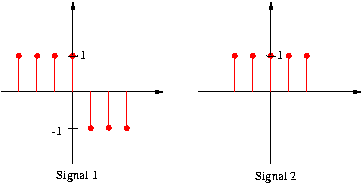

The program has a similar layout as the continuous-time program. To define your own signal, click and drag the dot of the sample you would like to change."
| Signal 1: | Signal 2: |
|---|---|
Problem 1:
Perform convolutions of the following 3 pairs of signals using the above program.


In part 1, problem 1 of this lab you found the impulse response of a system. Now, we want you to sample that impulse response and the given input signal. Use these sampled signals to perform a discrete time convolution. You can use the program above and set samples which are smaller than 0.1 to zero. Since the program only allows you to enter samples up to n=5, neglect any samples for n>5.
Is the waveform which results from the discrete-time convolution the same as (or similar to) what would be obtained by sampling the result of the continuous-time convolution of the analog signals? Does the sampling rate make a difference? (make comparison in terms of both the shape and sample values)
For sampling rate, use
Hint: Calculate sample values on paper and then drag the samples to set them to desired values.
For 1s sampling rate, samples will be taken at 0s,1s,2s,... . For 250ms sampling rate, samples will be taken at 0s, 0.25s, 0.5s,... .